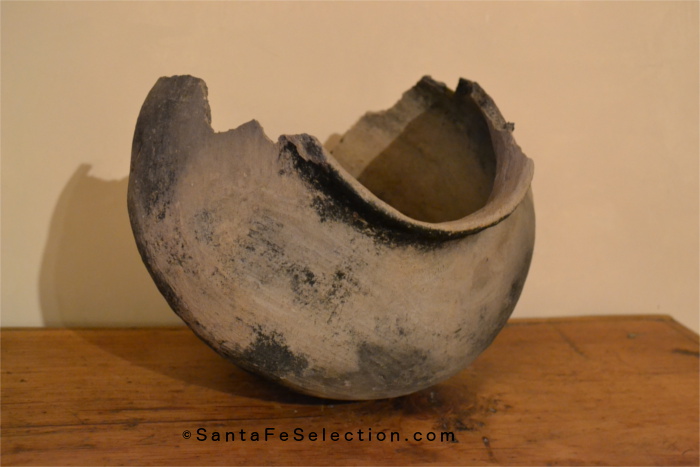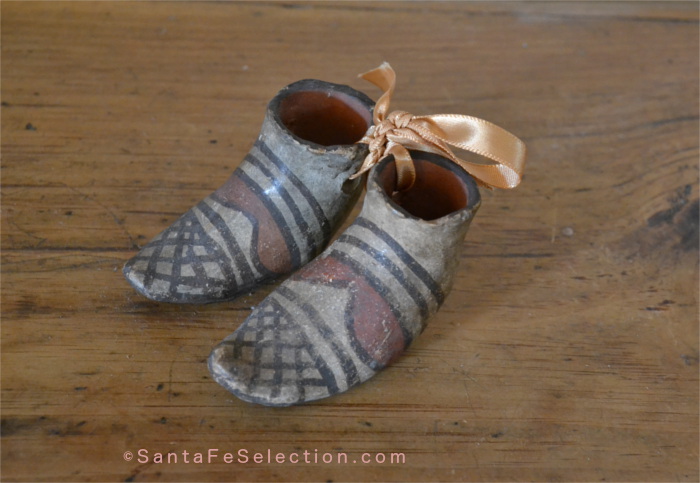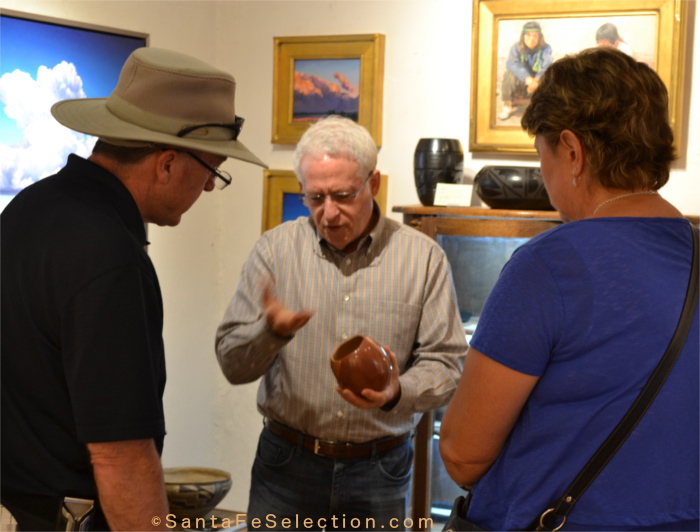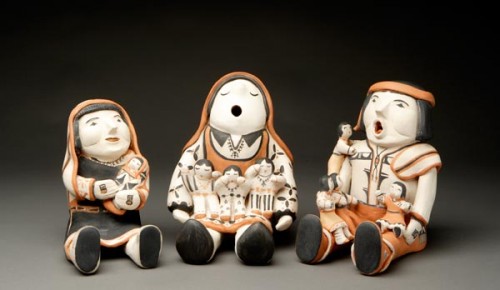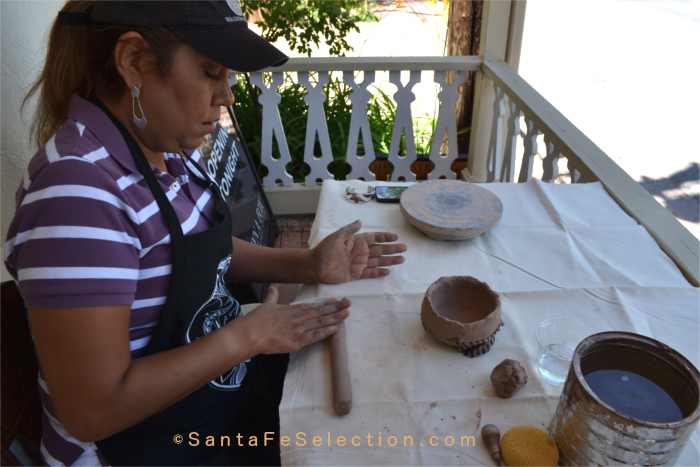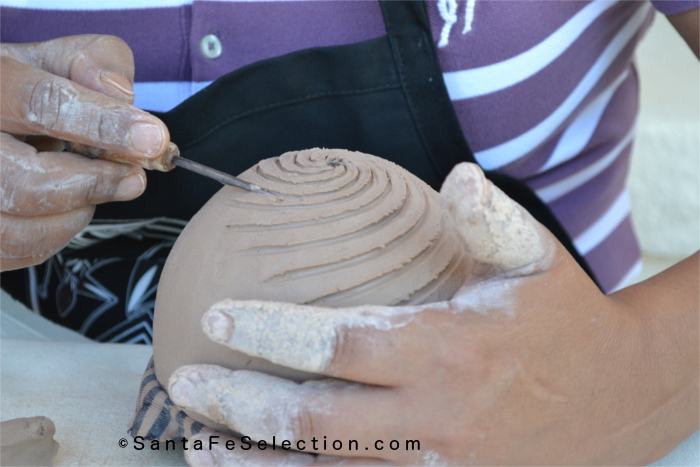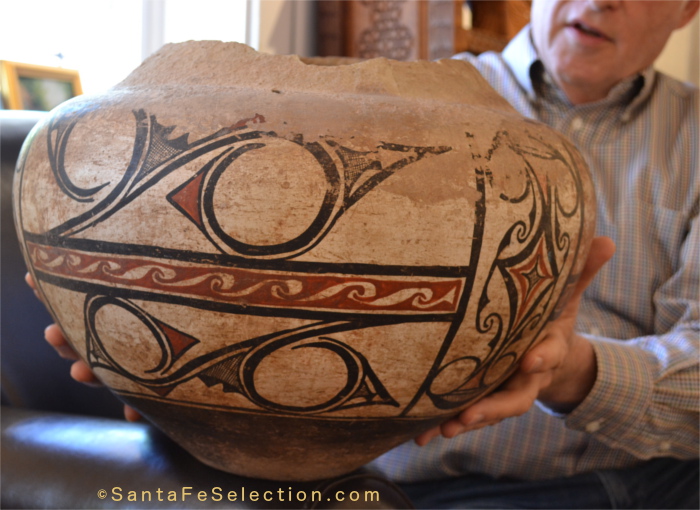From earth to art, a world of tradition, culture and reverence lies at the heart of Native American pueblo pottery. Its history dates back 7500 years.
Today, a number of Native potters are known around the world for their exquisite forms and unsurpassed craftsmanship. Some of the better known names include Maria Martinez, Margaret Tafoya, Popovi Da and Tony Da, to mention a few.
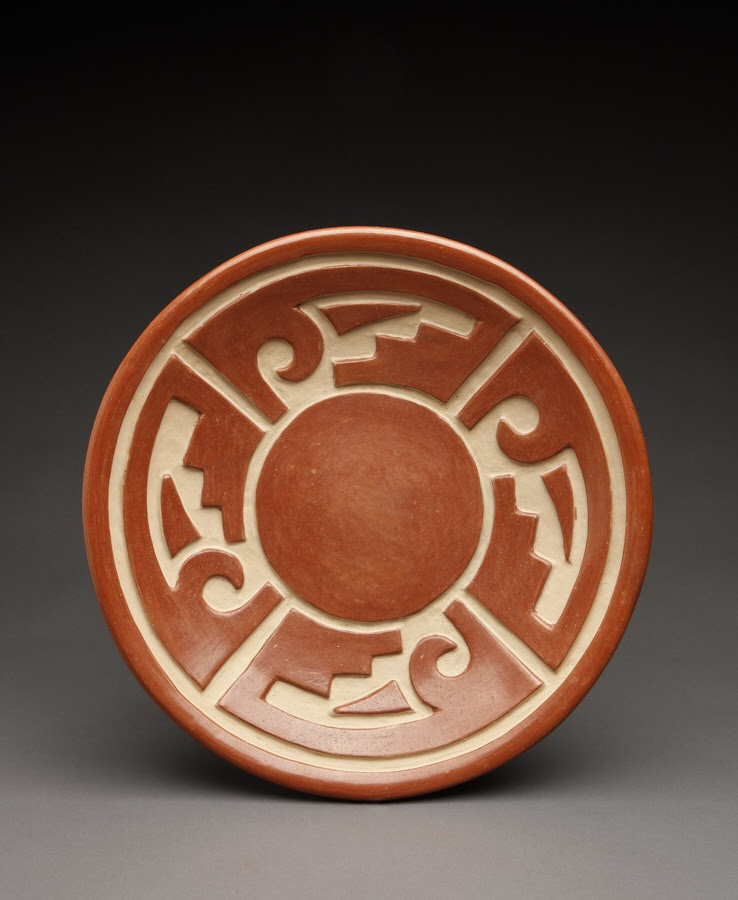
Rare large plate/shallow bowl by Margaret Tafoya of Santa Clara Pueblo. Circa 1935. Image courtesy Lyn A. Fox Gallery, Santa Fe.
Naturally, pottery has always been a highly valued necessity of life in Native pueblo homes. All forms from water jars and dough bowls, to storage jars, plates and many more, were hand-made by family members. These necessary utensils were often so beautifully well crafted and uniquely painted that they would endure the passage of time and heavy use to be passed down from generation to generation.
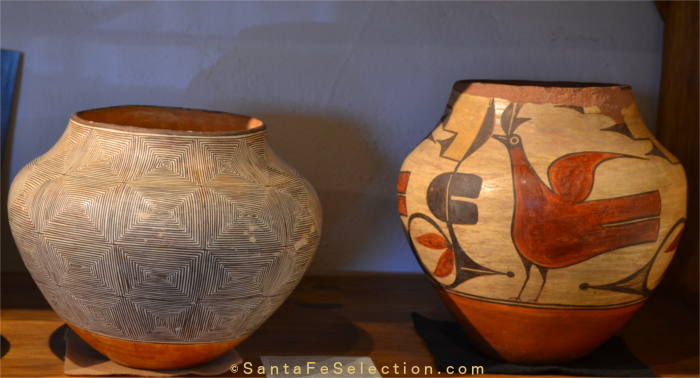
Two pots at Lyn A. Fox Gallery: left is an Acoma fine line jar by Lucy Lewis, c. 1950; right is a Zia 4-color water jar with rim wear from pueblo home use, attributed to Harviana Toribio, c. 1920
The process of creating pottery — gathering the mud clays from nearby land, mixing the colored slips, firing in ground pits, and adapting just the right sized paint brush from yucca strands — remains one of spiritual reverence for some Native potters to this day. Not until relatively recently did the appreciation of Native American pottery as a valuable art form begin.
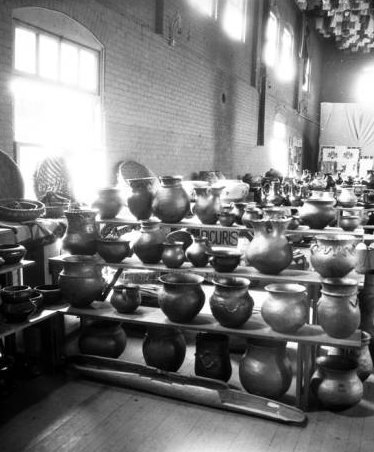
1922 Picuris Pueblo Pottery exhibit at the first Indian Market in Santa Fe. Image courtesy of Palace of the Governors photo archive.
In 1922, the first Indian Arts Fair took place in Santa Fe, which subsequently helped save the art from dwindling by encouraging the Native potters to make large forms as art pieces for competition and sale. This would also lead to more innovative and highly collectible contemporary creations.
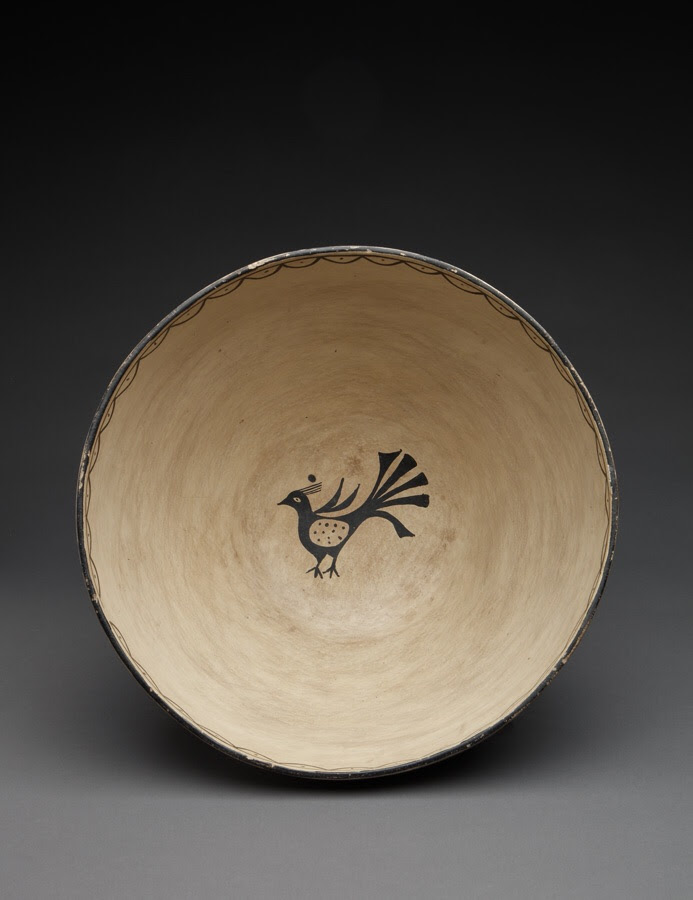
1930s early art market piece. Cochiti dough bowl, with inner small bird, attributed to Ignacita Suiña. 8″deep x15″ wide.
Until then, the presence of sellable larger pieces was dwindling because Native potters were mostly making small, portable pieces as souvenirs for tourists. During the late 1800s, often referred to as the Harvey Era, the Atchison, Topeka, Santa Fe Railway brought travelers to the Southwest. The stops en route would allow tourists to buy small pieces of Native art and craft that were easy to take home in their luggage.
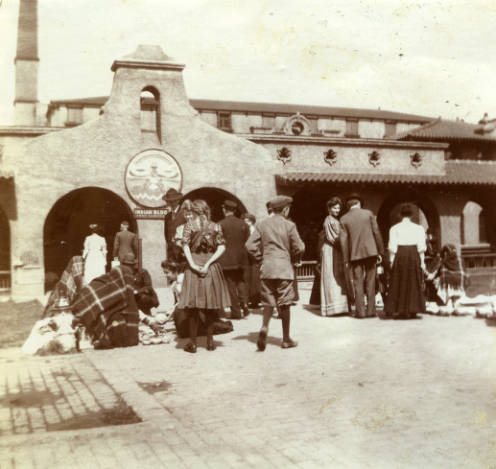
Fred Harvey Indian Building. Albuquerque. Train travelers stretch their legs and shop from Native vendors while waiting to continue their journey.
Below is an example of a souvenir, or tourist piece. These boots are only 3 inches long by 2 inches tall. Such small pieces are generating interest from collectors once more. It’s rare to find such a small, intact pair, since most were broken, discarded, or lost over the years. In 1910, they probably cost as little as 25 cents. Not so now. They have recently been priced at $650.
Because of the fine Native American craftsmanship, and the enduring beauty and cultural significance of forms of all sizes, pueblo pottery is now one of the most sought-after and highly-valued Native arts. The market is vast, and filled with the potential for many expensive mistakes to be made by a novice enthusiast, such as myself.
Lyn Fox is one of Santa Fe’s leading Native American pottery aficionados. He works closely with pueblo artists, supporting them in their craft and teaching his knowledge to those of us in search of quality historical and contemporary forms. It helps to know someone like Lyn if you want to avoid common pitfalls.
He learned first-hand how easily an enthusiast can be misled into buying works that are poorly made, not authentic, or overvalued.
Lyn began his collection with the purchase of a small, and quite misshapen storyteller piece from a potter’s home in Cochiti Pueblo more than 25 years ago. Below are some fine examples of storyteller pieces.
It was at that time he became enthralled with the heart and soul of the Native people, their culture, and this particular craft. He has since dedicated his time and energy to working closely with artists, building his knowledge of Native American pueblo pottery and sharing it with enthusiasts. At the Lyn A. Fox Gallery on Canyon Road, he works to support young, up-and-coming pueblo artists such as Dominique Toya of Jemez Pueblo, while also continuing his search for rare historical forms.
Dominique recently demonstrated her work at Lyn’s gallery. It was fascinating to watch as she brought a beautiful piece to life from coils of clay.
She has won many awards for her work. At the 2015 SWAIA Indian Market, Dominique won three ribbons, including the prestigious Blue Ribbon for Best Pottery Miniatures.
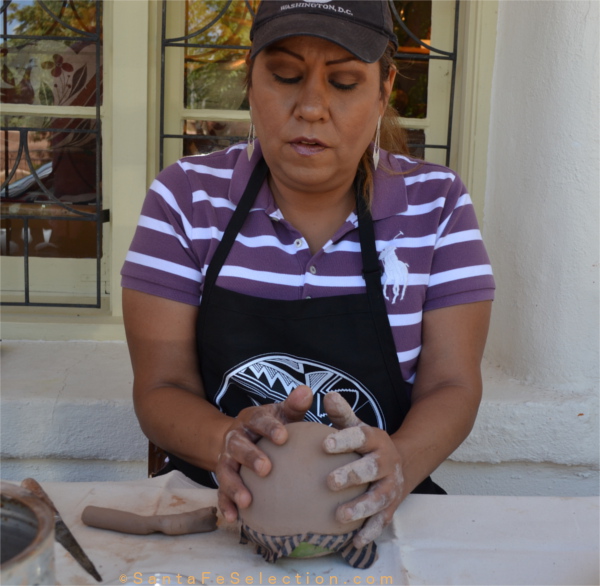
Dominique Toya of Jemez Pueblo. The seed pots are enclosed pieces, said to contain seeds or other items of personal value.
Despite the inventions of the kiln and potter’s wheel, Dominique continues to use the traditional methods passed down through her family.
From clay gathering and traditional pit firing, to painting, she says, “the whole experience is a way of honoring the earth and our Native heritage.”
Although she continues to work in much the same way as her ancestors did, her creativity expands the form’s beauty and design in contemporary ways.
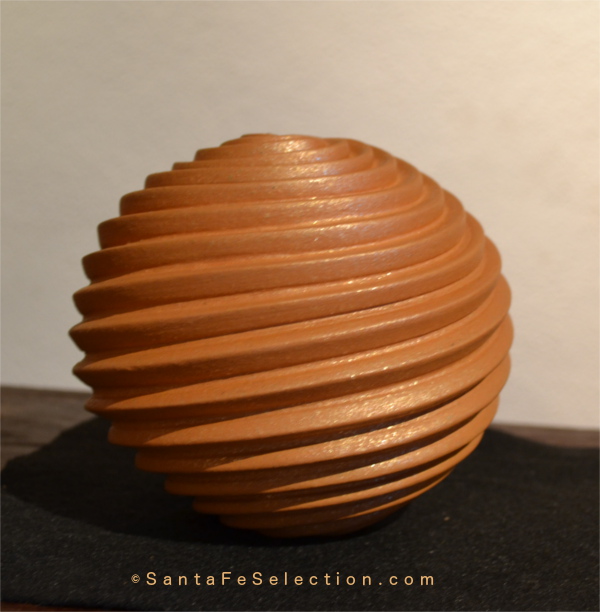
Dominique Toya – Jemez Pueblo. Finished Seed Pot. The special mica clay blend that she gathers from her home casts a glow to the perfectly carved piece.
Lyn’s gallery shelves are filled with contemporary and historic pieces, some dating back to the 1800s. He has a passion for the historic pieces and calls them “miracles of use, love, survival, respect, creativity and family history.” And among those we should thank are the generations of collectors who have loved and protected these fragile works, so that new owners can acquire and enjoy them today and into the future.
As he showed me this beautiful Zuni storage jar, he said, “You can appreciate the special skill set it takes to do large pieces. And what it takes to paint the design of such fine marks with strands of yucca leaf. Its coloration is beautiful; the red is deep and the black is strong.” He continued to explain how this piece had been used by the original Native family so much it has become potato-chip thin along the rim. It is unusable now, but it didn’t break and has become a rare, beautiful treasure.
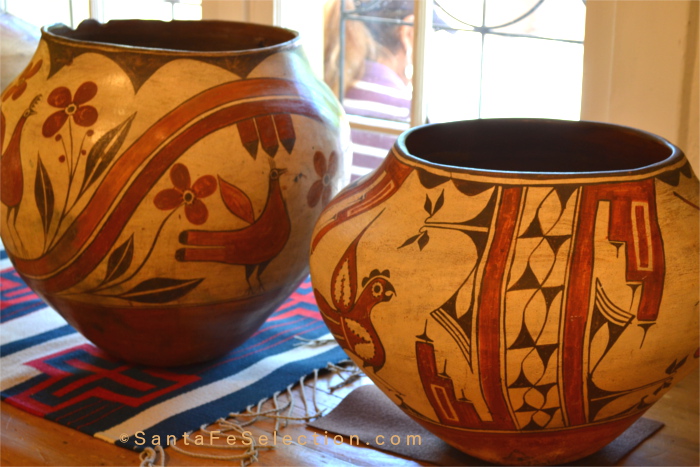
Historic Pots: Right: Zia 4-Color Large Storage Jar with Hide and Putch Native Repair, c. 1900; Left: A Large Polychrome Storage Jar with Birds and Rainbow Bands by Seferina Bell, c. 1945
Over time, magnificent pieces were traded, gifted, lost, or passed along through families, which adds an air of mystery that enhances their majesty and enduring beauty. In today’s rapid-fire environment where so much is disposable, I look at these historic and contemporary pieces as anchors to a world where quality and longevity matter.
Even when families part with these heirlooms, it’s a credit to the masterful potters that their history and family traditions, including the unique designs specific to a particular family, are passed down through generations, and continue to be loved and appreciated, spreading the admiration for their culture throughout the world.
For more information on Native American Pueblo Pottery and the Lyn A. Fox Gallery, click this link, or you may call Lyn Fox directly at (505) 577-0835.
If you have any questions about visiting Santa Fe, please email me at: info@SantaFeSelection.com, or call (505) 470-2991. Or go to our Travel Guide at SantaFeSelection.com to access easy maps, tips and ideas to help you plan your visit.
Thank you for reading this post! If you would like to receive my monthly articles, please go to the home page and enter your email in the “subscribe” field. See you in Santa Fe!!

